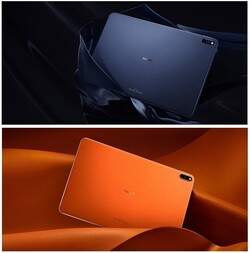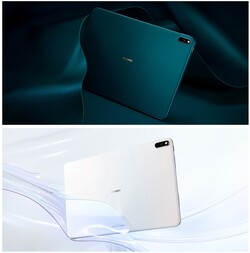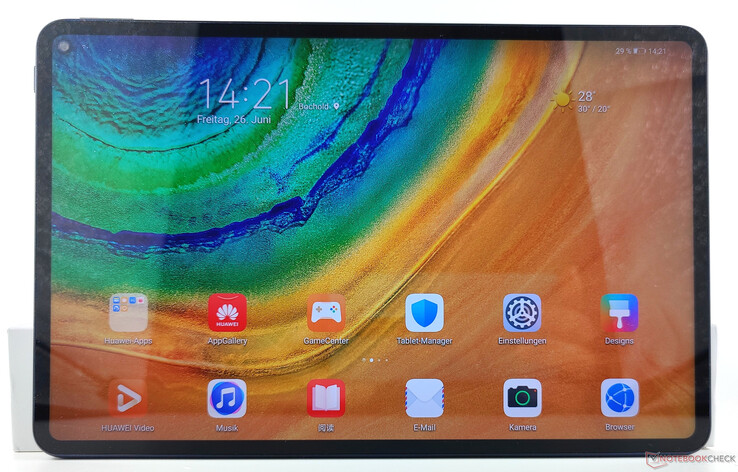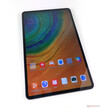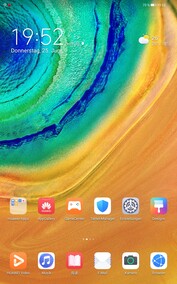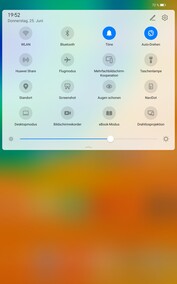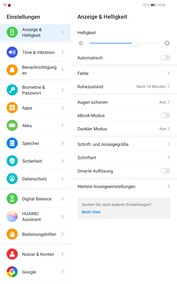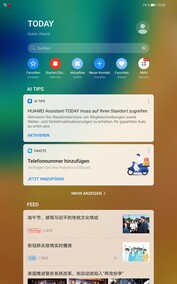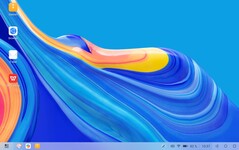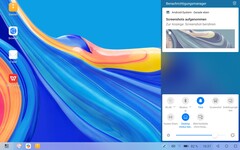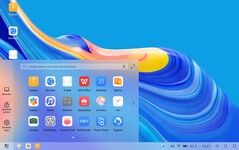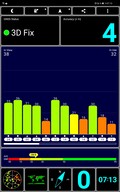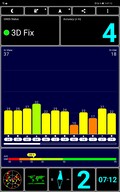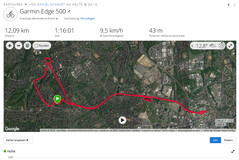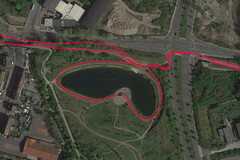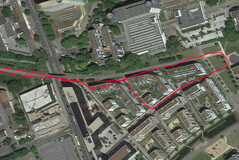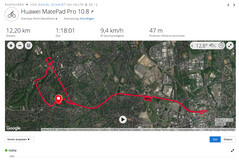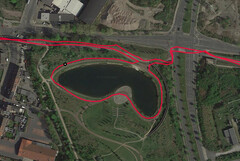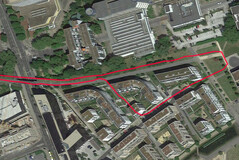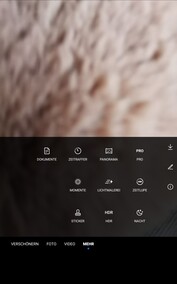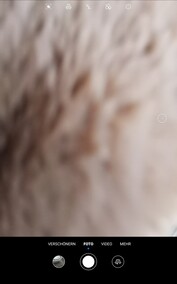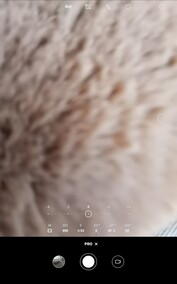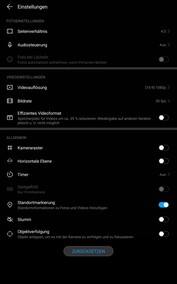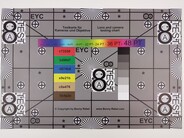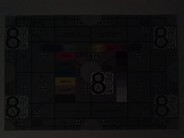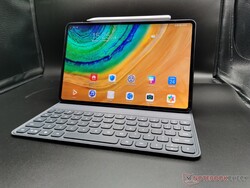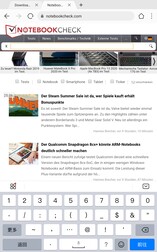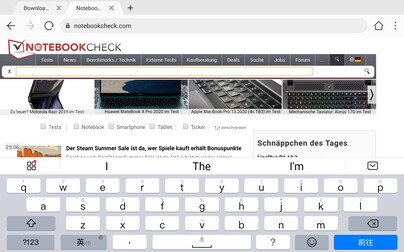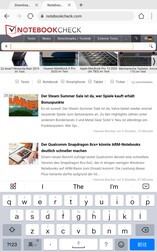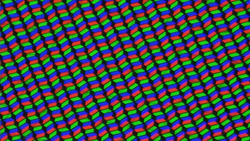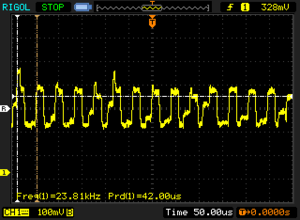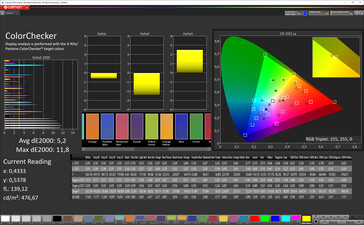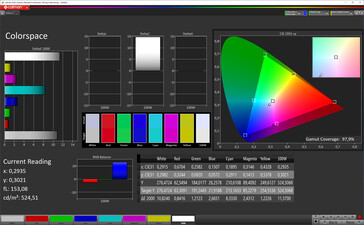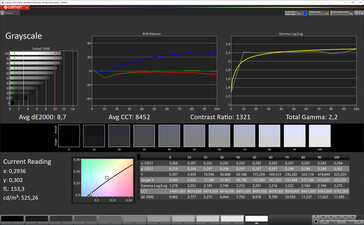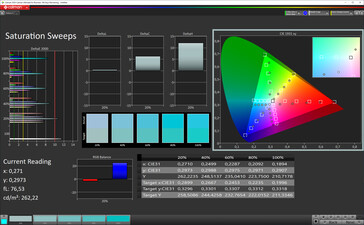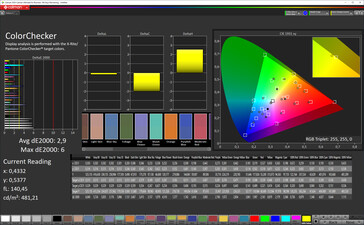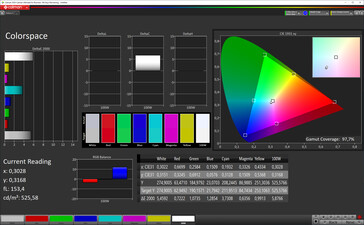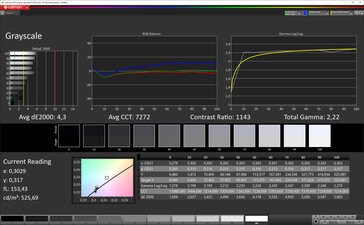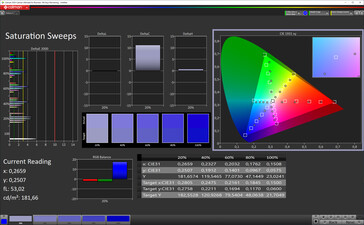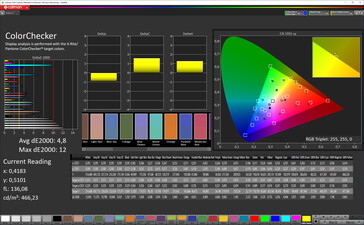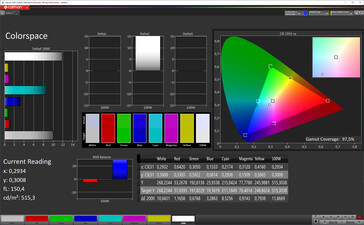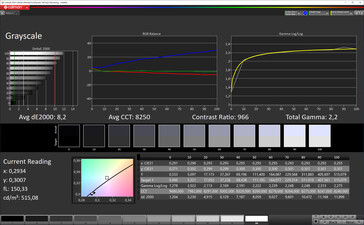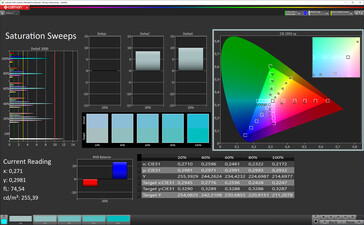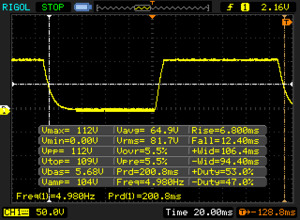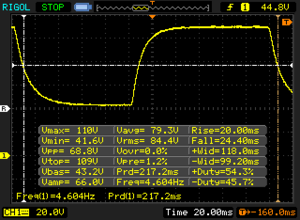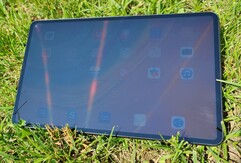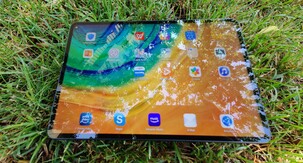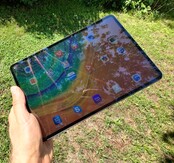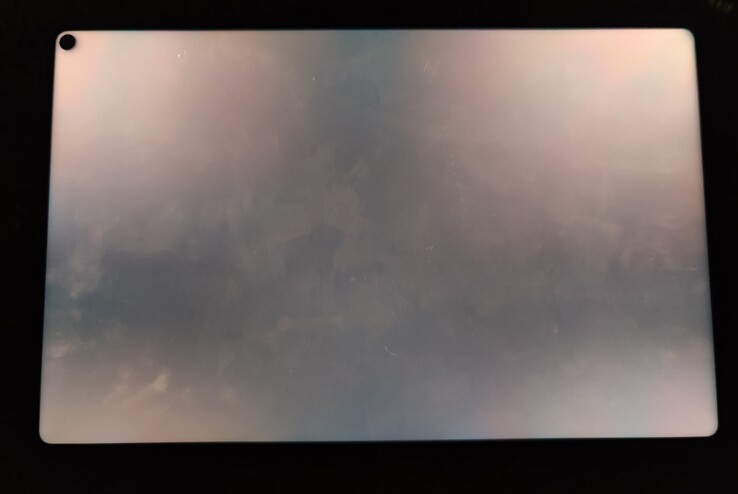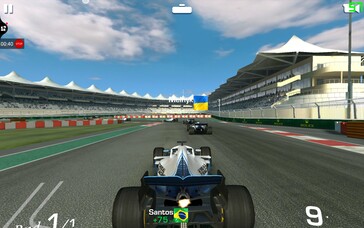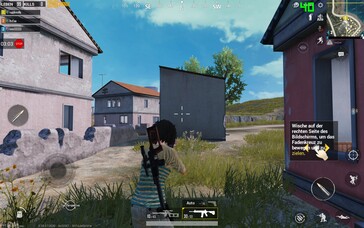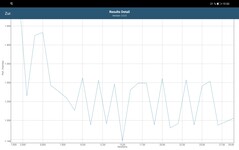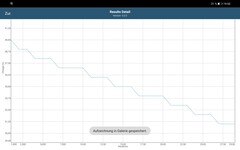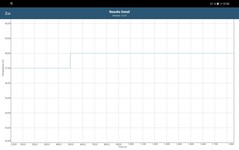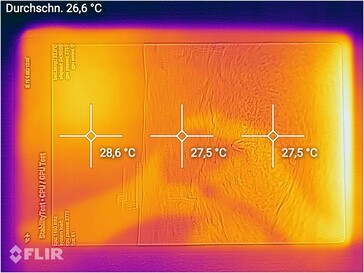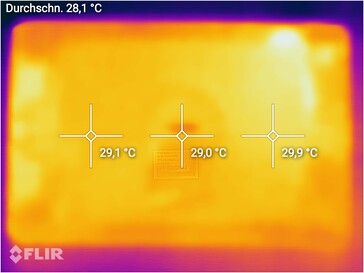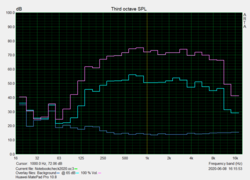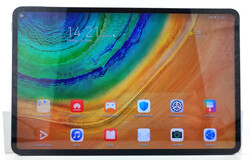Huawei MatePad Pro (5G) 10.8 tablet review - An Android alternative to the Apple iPad Pro 11?
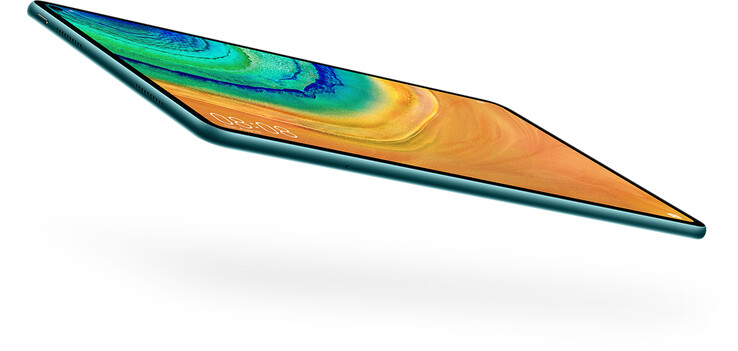
The MatePad Pro, which has been available in China for a long time, has now arrived in both the USA and Europe. Huawei uses the Kirin 990 SoC in its 7.2-mm thin and 460-gram iPad Pro alternative; it also sports a 1200p resolution, 10.8-inch IPS display. The MatePad Pro is the first Huawei tablet that not only supports 40-watt super charging via USB-C but also 27-watt wireless charging. The 7,250 mAh battery can also charge other devices via reverse wireless charging.
There are two models of the MatePad Pro. The first has 6 GB of RAM and 128 GB of UFS storage, and the second has 8 GB of RAM and 256 GB of internal storage. In addition to the LTE version available in China, a 5G version of the Pro tablet will also be available in Germany. The Chinese version of the WLAN variant starts at around 480 Euros (~$566), but LTE capabilities cost around 80 Euros more (~$94). In Europe, the 128 GB Wi-Fi version starts at 550 Euros (~$648).
Rating | Date | Model | Weight | Height | Size | Resolution | Best Price |
|---|---|---|---|---|---|---|---|
| 88.4 % | 08/2020 | Huawei MatePad Pro 10.8 Kirin 990, Mali-G76 MP16 | 460 g | 7.2 mm | 10.80" | 2560x1600 | |
| 90.4 % | 04/2020 | Apple iPad Pro 11 2020 A12Z Bionic, A12Z Bionic GPU | 471 g | 5.9 mm | 11.00" | 2388x1668 | |
| 87.8 % | 10/2019 | Samsung Galaxy Tab S6 SM-T860 SD 855, Adreno 640 | 420 g | 5.7 mm | 10.50" | 2560x1600 | |
| 83.1 % | 06/2020 | Samsung Galaxy Tab S6 Lite Exynos 9611, Mali-G72 MP3 | 467 g | 7 mm | 10.40" | 2000x1200 |
Case - Huawei tablet with a punch hole
The Huawei tablet is available in a total of four color options. So far, only “Midnight Gray” has made it to Europe. The 10.8-inch display of the MatePad Pro has a hole in the upper left corner, which makes the edges around the IPS panel relatively thin; however, the remaining 6 mm wide frame could have hidden the front camera to avoid the display shadowing that it causes. At just under 86%, the Huawei tablet has a relatively nice display-to-surface ratio, but it doesn't achieve the 90% ratio advertised by the device manufacturer.
With a case thickness of only 7 mm, the MatePad Pro looks pleasantly thin but is somewhat "thicker" than the competition in this price segment. The manufacturing of the case and the pressure points of the built-in buttons are excellent. The Huawei tablet does not have IP certification.
Features - MatePad Pro with a status LED
The features of the MatePad Pro include Miracast, a status LED, and USB OTG. The USB port has a Type-C design with a USB 3.1 (Gen1) connection. After the initial setup, the 256 GB of internal UFS 3.0 memory of our test device only had 237 GB available due to the space requirements of the operating system and preinstalled applications. The MatePad Pro does not support an expansion of the permanently installed data memory via SD cards. If you need more storage space, you have to use an NM memory card. exFAT and FAT32 formatted cards up to 256 GB in size are supported.
Due to the lack of Google certifications, DRM-protected content can only be viewed in 540p/480p on the Chinese version. Even in the European version of the Huawei tablet, video content on video-streaming services will probably not be able to be viewed in HD quality, as there is no Widevine Level 1 certification. As soon as we receive a German test sample, we will verify whether this limitation also exists on that model.
Software - Huawei MatePad Pro with Android 10
The Chinese manufacturer uses Android version 10 for its operating system, which is supplemented by a highly customized user interface. Huawei also installed its user interface EMUI 10, which is based on the open source part of Android. The security patches are also included so that Huawei can continue to ensure that its operating system is secure. With our MatePad Pro, the security patches were up to date as of April 2020 at the time of the test.
However, Huawei is no longer allowed to use Google services, so most Google apps and many third-party apps do not work - the installation of the Google Play Store is also not possible without further work (interfering with administration rights). We attempted to install Google applications such as Chrome using relatively secure alternative platforms such as APKMirror, but we were not successful; the same applies to apps (including Feedly) that require a Google account to be registered. Trying to transfer your favorite Google apps via the PhoneClone app also fails on the MatePad Pro.
The Huawei AppGallery and its "App Search" provide at least a partial remedy. The latter makes it possible to find your favorite apps via websites or alternative stores. This is not as convenient as with Google-certified Android tablets, and more than just being uncomfortable, the lack of automatic updates also presents some security risks. The AppGallery itself offers some popular apps, but many popular messenger and social media apps are missing because these are often owned by American companies.
Apart from the great difficulties that come from the missing GMS, the MatePad Pro offers some nice features in terms of software, such as real multitasking thanks to the Huawei App Multiplier. Windows can be individually resized, but these features must be supported by the respective app developer. A special desktop mode also makes it possible to arrange several applications into differently sized windows.
Huawei offers another feature for productivity with the pen controls and the preinstalled graphics and note-taking applications, which is similar to what the Apple iPad Pro does with the Apple Pencil. Using Huawei Share, the screen of a Huawei smartphone can also be projected onto the MatePad Pro; a user can then, among other features, make calls and send texts using the tablet. Files can also be moved and edited between the two Huawei devices using simple drag & drop motions.
Communication and GPS - Huawei tablet with fast Wi-Fi & GPS
Some models of the Huawei MatePad Pro can access the Internet using only the LTE frequency, but some can also use the 5G cellular standard. In the WLAN version, the Chinese manufacturer uses Bluetooth version 5.1 as its communication module, but users should avoid using NFC.
A Wi-Fi 5 module with MIMO antenna technology is used for Wi-Fi connections. In conjunction with our Netgear Nighthawk AX12 reference router, very high peak values of up to 1.1 Gb/s are achieved when receiving data, though the transmission rates when sending data are somewhat less consistent.
| Networking | |
| iperf3 transmit AX12 | |
| Huawei MatePad Pro 10.8 | |
| Apple iPad Pro 11 2020 | |
| Samsung Galaxy Tab S6 SM-T860 | |
| Samsung Galaxy Tab S6 Lite | |
| iperf3 receive AX12 | |
| Huawei MatePad Pro 10.8 | |
| Samsung Galaxy Tab S6 SM-T860 | |
| Samsung Galaxy Tab S6 Lite | |
| Apple iPad Pro 11 2020 | |
On our test bike ride, the tablet had to compete with the Garmin Edge 500 navigation device. The two GPS modules were roughly 110 meters apart on the approximately 12-kilometer route. Minor inaccuracies of the MatePad Pro are noticeable around the turning point of the route and the circling of the lake, but the Huawei tablet does not have major dropouts, so MatePad Pro users are well equipped for navigation tasks.
The Huawei tablet uses the GPS, Glonass, BeiDou, and Galileo satellite systems for geolocation. The satfix works quickly and precisely outdoors as well as in buildings.
Voice quality - MatePad Pro with conference qualities
A likely application for the MatePad Pro is video communications. With the user-installed Skype app, which can be easily installed via the Amazon AppStore, we take a closer look at the voice quality of the built-in microphone. Our conversation partners felt that our voice was reproduced clearly and loudly by the five microphones in the MatePad Pro. The voice reproduction by the built-in speakers is also appealing.
Cameras - MatePad Pro with good cameras
On the back, there is a 13-megapixel single camera with an aperture of f/1.8. The image sharpness and details of the shots are very appealing in a lot of light, although the MatePad Pro has problems choosing the right exposure. Nevertheless, the photos of the 13 MP camera are visually appealing for this product class. In the dark, however, the problems with photos become obvious. Low-light shots are poorly lit, grainy, and not very sharp.
In the small hole in the display, there is an 8-megapixel front camera with an f/2.0 aperture. The results are solid and well suited for social media posts or video news so long as the beauty mode is deactivated. Videos can be recorded at 1080p at 30 FPS. With the main camera, the MatePad Pro records moving pictures in UHD at 30 FPS.
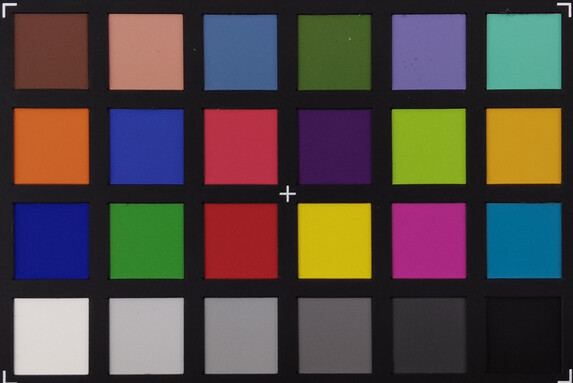
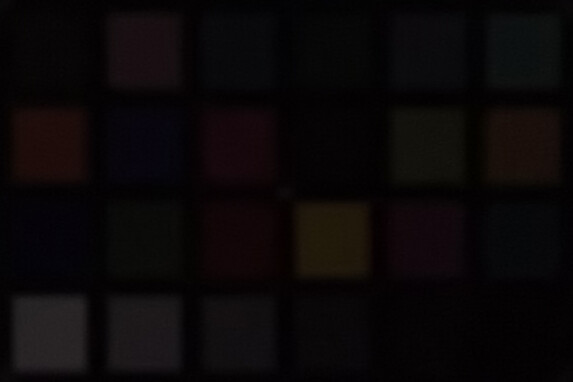
Accessories and warranty - MatePad Pro with pen and keyboard case
In addition to the MatePad Pro, our box contained a modular, Chinese power supply with a nominal output of 20-watts and a USB charging cable. TradingShenzhen also includes an EU adapter for the sockets used in this region; this is not part of the standard package, though, but is instead just a service provided by the provider who lent us this device.
The MatePad Pro also offers optional accessories for other input methods. The Huawei Smart Keyboard, which costs around 130 Euros (~$153), turns the MatePad Pro into a mobile 2-in-1 device and serves as a protective cover on the go. The Huawei M-Pencil, which costs around 100 Euros (~$118), supports 4,096 pressure levels, and it should achieve a latency of 20 ms when drawing, holds onto the tablet magnetically and the tablet wirelessly charges within an hour (according to the manufacturer).
Huawei provides a warranty period of 24 months for its tablet. In addition to the manufacturer's guarantee, TradingShenzhen provides the option of sending the MatePad Pro to a German shipping address in the event of a warranty claim. By using this, time-consuming shipping to China (for the Chinese version) can be avoided for the first 12 months.
Input devices & operation - MatePad Pro without fingerprint sensor
Touch input is registered quickly on the 10.8-inch IPS panel. The in-house Huawei keyboard is pre-installed as a virtual input option.
The MatePad Pro cannot be unlocked via finger biometric identification. The user can unlock the tablet using facial recognition, but this only works with the front camera. This works reliably and quickly in everyday life but is quite unsafe (2D).
Display - Huawei tablet with 60 Hz IPS display
The IPS display in the MatePad Pro has a resolution of 2560x1600 pixels with a 16:10 aspect ratio, but unlike the Apple iPad Pro 11's screen, this one only has a refresh rate of 60 Hz. Similar to Apple's TrueTone technology, the user can have the display's color temperature change in relation to the ambient light.
The maximum brightness with a pure white-screen background averages a very good 579 cd/m² - but Huawei uses pulse width modulation to control the display brightness, which is somewhat negative in light of the LC technology. The illumination around the front camera is also not optimal - shadows are clearly visible. When there is little ambient light and the display is dark, halos are also visible.
In addition, we checked the brightness distribution of the panel in our test by using a test pattern of evenly distributed proportion of dark to light areas (APL50). We found a maximum brightness of 610 cd/m². Without an activated ambient light sensor to control the display brightness, we measured a lower luminance of 519 cd/m².
| |||||||||||||||||||||||||
Brightness Distribution: 89 %
Center on Battery: 606 cd/m²
Contrast: 1894:1 (Black: 0.32 cd/m²)
ΔE Color 2.9 | 0.5-29.43 Ø5
ΔE Greyscale 4.3 | 0.57-98 Ø5.3
97.5% sRGB (Calman 2D)
Gamma: 2.22
| Huawei MatePad Pro 10.8 IPS, 2560x1600, 10.80 | Apple iPad Pro 11 2020 IPS, 2388x1668, 11.00 | Samsung Galaxy Tab S6 SM-T860 Super AMOLED, 2560x1600, 10.50 | Samsung Galaxy Tab S6 Lite TFT, 2000x1200, 10.40 | |
|---|---|---|---|---|
| Screen | 22% | 3% | -29% | |
| Brightness middle | 606 | 617 2% | 446 -26% | 503 -17% |
| Brightness | 579 | 585 1% | 445 -23% | 477 -18% |
| Brightness Distribution | 89 | 84 -6% | 86 -3% | 91 2% |
| Black Level * | 0.32 | 0.36 -13% | 0.29 9% | |
| Contrast | 1894 | 1714 -10% | 1734 -8% | |
| Colorchecker dE 2000 * | 2.9 | 0.94 68% | 2.7 7% | 4.4 -52% |
| Colorchecker dE 2000 max. * | 6 | 1.87 69% | 5.4 10% | 10.4 -73% |
| Greyscale dE 2000 * | 4.3 | 1.4 67% | 2.1 51% | 7.5 -74% |
| Gamma | 2.22 99% | 2.156 102% | 2.05 107% | 2.19 100% |
| CCT | 7272 89% | 6733 97% | 6468 100% | 7700 84% |
* ... smaller is better
Screen Flickering / PWM (Pulse-Width Modulation)
| Screen flickering / PWM detected | 23810 Hz | ≤ 38 % brightness setting | |
The display backlight flickers at 23810 Hz (worst case, e.g., utilizing PWM) Flickering detected at a brightness setting of 38 % and below. There should be no flickering or PWM above this brightness setting. The frequency of 23810 Hz is quite high, so most users sensitive to PWM should not notice any flickering. In comparison: 53 % of all tested devices do not use PWM to dim the display. If PWM was detected, an average of 17924 (minimum: 5 - maximum: 3846000) Hz was measured. | |||
While our impression of the display up to this point has been middling, the good black value of 0.32 cd/m² (APL50: 0.32 cd/m²) starts to move things into a more positive direction. The rich black of the LC panel ensures high contrasts (1:1,894).
In terms of color and grayscale accuracy, however, there is again room for improvement. Here, the IPS panel has relatively small Delta-E deviations alongside P3 color-space coverage, but an iPad Pro 11 clearly does better in our measurements.
Display Response Times
| ↔ Response Time Black to White | ||
|---|---|---|
| 19.2 ms ... rise ↗ and fall ↘ combined | ↗ 6.8 ms rise | |
| ↘ 12.4 ms fall | ||
| The screen shows good response rates in our tests, but may be too slow for competitive gamers. In comparison, all tested devices range from 0.1 (minimum) to 240 (maximum) ms. » 36 % of all devices are better. This means that the measured response time is better than the average of all tested devices (21.5 ms). | ||
| ↔ Response Time 50% Grey to 80% Grey | ||
| 44.4 ms ... rise ↗ and fall ↘ combined | ↗ 20 ms rise | |
| ↘ 24.4 ms fall | ||
| The screen shows slow response rates in our tests and will be unsatisfactory for gamers. In comparison, all tested devices range from 0.2 (minimum) to 636 (maximum) ms. » 72 % of all devices are better. This means that the measured response time is worse than the average of all tested devices (33.7 ms). | ||
Thanks to the liquid crystal display used with in-plane switching technology (IPS), the MatePad Pro's display is largely color-stable, but colors do get somewhat distorted at very flat viewing angles - at these angles, the colors become slightly reddish. The drop in brightness is also clearly noticeable from flat viewing angles.
Performance - Huawei Tab with HiSilicon Kirin 990
The HiSilicon Kirin 990 in the MatePad Pro is an ARM-based octa-core SoC consisting of four Cortex-A76 cores and four A55 cores. The successor to the Kirin 980 has an integrated Mali-G76 MP16 GPU and a neural processor (1 + 1 cores) for AI tasks, and it is manufactured using the 7-nanometer process. The 5G version of the chipset has a slightly higher clock speed and has an integrated Balong 5G modem.
The processor performance is at a very attractive level, although the ideal performance of the Snapdragon 865 is not achieved. The values in the graphics benchmarks are unexpectedly low. In GFXBench, the MatePad Pro sometimes achieved lower refresh rates than the Qualcomm Adreno 640 in the Samsung Galaxy Tab S6. The MatePad Pro is clearly behind the Huawei Mate 30 Pro in terms of graphical power.
The performance with the Huawei tablet is very good during everyday use. Animations and scrolling are smooth, although the 60 Hz refresh rate of the panel has a somewhat limiting effect here. Further, thanks to the fast UFS memory, loading times are very short, even for complex apps.
| AnTuTu v8 - Total Score | |
| Apple iPad Pro 11 2020 | |
| Xiaomi Mi 10 Pro | |
| Samsung Galaxy S20 Ultra | |
| Average HiSilicon Kirin 990 (409039 - 483224, n=2) | |
| Huawei MatePad Pro 10.8 | |
| Samsung Galaxy Tab S6 Lite | |
| Jetstream 2 - Total Score | |
| Apple iPad Pro 11 2020 (Safari 14.1) | |
| Apple iPad Pro 11 2020 (Chrome 80) | |
| Average of class Tablet (19.9 - 236, n=59, last 2 years) | |
| Samsung Galaxy Tab S6 SM-T860 (Chrome 77.0.3865.116) | |
| Average HiSilicon Kirin 990 (55.1 - 65.9, n=2) | |
| Huawei MatePad Pro 10.8 (Huawei Browser V10.1.2) | |
| Samsung Galaxy Tab S6 Lite (Chrome 80.0.3987.99) | |
| JetStream 1.1 - Total Score | |
| Apple iPad Pro 11 2020 (Chrome 80) | |
| Samsung Galaxy Tab S6 SM-T860 (Chrome 77.0.3865.116) | |
| Average HiSilicon Kirin 990 (101.2 - 115.5, n=2) | |
| Huawei MatePad Pro 10.8 (Huawei Browser V10.1.2) | |
| Average of class Tablet (57.3 - 135.7, n=5, last 2 years) | |
| Samsung Galaxy Tab S6 Lite (Chrome 80.0.3987.99) | |
| WebXPRT 3 - Overall | |
| Apple iPad Pro 11 2020 (Safari 14.1) | |
| Apple iPad Pro 11 2020 (Chrome 80) | |
| Average of class Tablet (34 - 342, n=42, last 2 years) | |
| Average HiSilicon Kirin 990 (97 - 119, n=2) | |
| Samsung Galaxy Tab S6 SM-T860 (Chrome 77.0.3865.116) | |
| Huawei MatePad Pro 10.8 (Huawei Browser V10.1.2) | |
| Samsung Galaxy Tab S6 Lite (Chrome 80.0.3987.99) | |
| Speedometer 2.0 - Result | |
| Apple iPad Pro 11 2020 (Safari 14.1) | |
| Average of class Tablet (14.7 - 376, n=52, last 2 years) | |
| Average HiSilicon Kirin 990 (63.9 - 74.1, n=2) | |
| Samsung Galaxy Tab S6 SM-T860 (Chrome 77.0.3865.116) | |
| Huawei MatePad Pro 10.8 (Huawei Browser V10.1.2) | |
| Samsung Galaxy Tab S6 Lite (Chrome 80.0.3987.99) | |
| Octane V2 - Total Score | |
| Apple iPad Pro 11 2020 (Safari 14.1) | |
| Apple iPad Pro 11 2020 (Chrome 80) | |
| Samsung Galaxy Tab S6 SM-T860 (Chrome 77.0.3865.116) | |
| Average of class Tablet (2672 - 74614, n=72, last 2 years) | |
| Average HiSilicon Kirin 990 (19885 - 23568, n=2) | |
| Huawei MatePad Pro 10.8 (Huawei Browser V10.1.2) | |
| Samsung Galaxy Tab S6 Lite (Chrome 80.0.3987.99) | |
| Mozilla Kraken 1.1 - Total | |
| Samsung Galaxy Tab S6 Lite (Chrome 80.0.3987.99) | |
| Average of class Tablet (451 - 34733, n=59, last 2 years) | |
| Huawei MatePad Pro 10.8 (Huawei Browser V10.1.2) | |
| Samsung Galaxy Tab S6 SM-T860 (Chrome 77.0.3865.116) | |
| Average HiSilicon Kirin 990 (1963 - 2345, n=2) | |
| Apple iPad Pro 11 2020 (Chrome 80) | |
* ... smaller is better
| Huawei MatePad Pro 10.8 | Samsung Galaxy Tab S6 SM-T860 | Samsung Galaxy Tab S6 Lite | Average 256 GB UFS 3.0 Flash | Average of class Tablet | |
|---|---|---|---|---|---|
| AndroBench 3-5 | -13% | -34% | -7% | -22% | |
| Sequential Read 256KB | 1789 | 1416 -21% | 483.7 -73% | 1573 ? -12% | 850 ? -52% |
| Sequential Write 256KB | 399 | 522 31% | 219.3 -45% | 559 ? 40% | 532 ? 33% |
| Random Read 4KB | 224.6 | 191.6 -15% | 119.8 -47% | 209 ? -7% | 167 ? -26% |
| Random Write 4KB | 262.4 | 170.2 -35% | 195.8 -25% | 186.4 ? -29% | 150.8 ? -43% |
| Sequential Read 256KB SDCard | 82.4 ? | 70.5 ? -14% | 78.3 ? -5% | 70.6 ? -14% | |
| Sequential Write 256KB SDCard | 71.7 ? | 54.5 ? -24% | 65.3 ? -9% | 59.8 ? -17% |
Games - Mali-G76 MP16 as a GPU in the MatePad Pro
The Mali-G76 MP16 uses 16 clusters and is based on the 2nd generation of the Bifrost architecture. The offered graphics performance ensures smooth gameplay even while playing demanding games like PUBG Mobile using the highest details. The shooter holds a frame rate of around 40FPS even when playing with the highest quality. When using the lowest graphics settings on PUBG or playing the racing game Real Racing 3, framerates of up to 60 FPS are possible. We use the GameBench app to determine the frame rates.
The integrated position sensors work without problems during gaming, and the touchscreen works precisely.
PUBG Compare
Real Racing 3
Emissions - Hardly any waste heat from the MatePad Pro
Temperature
The case of the MatePad Pro hardly gets warm during everyday use. We used the battery test of the GFXBench app to check how much waste heat is generated during a sustained load. The Manhattan 3.1 test shows that the frame rate drops significantly after a short load, which means that performance drops under load are possible.
(+) The maximum temperature on the upper side is 32.6 °C / 91 F, compared to the average of 33.8 °C / 93 F, ranging from 20.7 to 53.2 °C for the class Tablet.
(+) The bottom heats up to a maximum of 29.6 °C / 85 F, compared to the average of 33.3 °C / 92 F
(+) In idle usage, the average temperature for the upper side is 28.3 °C / 83 F, compared to the device average of 30 °C / 86 F.
Speaker
We really like the quad-speaker sound system of the MatePad Pro. The four speakers are sufficiently loud at just under 84 dB and hardly distort. The recorded curve in the pink noise test is relatively linear, and there is a reasonable bass response.
The sound is outputted to external devices via USB-C and Bluetooth. Unfortunately, the MatePad Pro does not have a 3.5 mm jack plug. In the case of wireless playback using BT 5.1, the aptX HD codec can't be used.
Huawei MatePad Pro 10.8 audio analysis
(+) | speakers can play relatively loud (83.8 dB)
Bass 100 - 315 Hz
(±) | reduced bass - on average 10.9% lower than median
(±) | linearity of bass is average (11.9% delta to prev. frequency)
Mids 400 - 2000 Hz
(+) | balanced mids - only 2.6% away from median
(+) | mids are linear (3.3% delta to prev. frequency)
Highs 2 - 16 kHz
(+) | balanced highs - only 2.2% away from median
(+) | highs are linear (3.8% delta to prev. frequency)
Overall 100 - 16.000 Hz
(+) | overall sound is linear (12.4% difference to median)
Compared to same class
» 13% of all tested devices in this class were better, 4% similar, 83% worse
» The best had a delta of 7%, average was 23%, worst was 129%
Compared to all devices tested
» 8% of all tested devices were better, 2% similar, 90% worse
» The best had a delta of 4%, average was 25%, worst was 134%
Apple iPad Pro 11 2020 audio analysis
(±) | speaker loudness is average but good (78.5 dB)
Bass 100 - 315 Hz
(±) | reduced bass - on average 6.3% lower than median
(±) | linearity of bass is average (7.6% delta to prev. frequency)
Mids 400 - 2000 Hz
(±) | higher mids - on average 6.4% higher than median
(+) | mids are linear (6% delta to prev. frequency)
Highs 2 - 16 kHz
(+) | balanced highs - only 1.9% away from median
(+) | highs are linear (6.2% delta to prev. frequency)
Overall 100 - 16.000 Hz
(+) | overall sound is linear (13% difference to median)
Compared to same class
» 17% of all tested devices in this class were better, 3% similar, 81% worse
» The best had a delta of 7%, average was 23%, worst was 129%
Compared to all devices tested
» 10% of all tested devices were better, 2% similar, 88% worse
» The best had a delta of 4%, average was 25%, worst was 134%
Power management - Huawei tablet with wireless charging
Energy consumption
The MatePad Pro is the first Huawei tablet to support 15-watt wireless charging, and 7.5-watt reverse wireless charging is also possible. When using the 20-watt fast charging power supply, the battery is recharged after 2 hours. However, even when connected to main power, the tablet loses battery power when under load since the included power supply is (apparently) not powerful enough.
| Off / Standby | |
| Idle | |
| Load |
|
| Huawei MatePad Pro 10.8 7250 mAh | Apple iPad Pro 11 2020 7538 mAh | Samsung Galaxy Tab S6 SM-T860 7040 mAh | Samsung Galaxy Tab S6 Lite 7040 mAh | |
|---|---|---|---|---|
| Power Consumption | -36% | 11% | 12% | |
| Idle Minimum * | 1.98 | 1.3 34% | 1.96 1% | 1.21 39% |
| Idle Average * | 5.66 | 3.5 38% | 2.8 51% | 4.24 25% |
| Idle Maximum * | 5.69 | 5.6 2% | 2.82 50% | 4.34 24% |
| Load Average * | 6.96 | 12.5 -80% | 5.31 24% | 6.99 -0% |
| Load Maximum * | 6.98 | 19.2 -175% | 11.91 -71% | 8.79 -26% |
* ... smaller is better
Battery life
The MatePad Pro lasted about 15 hours in our Wi-Fi test. While using maximum brightness, the lights on the Huawei tablet went out after about 4 hours under load. Thanks to the 7,250 mAh battery, the device can last long enough for a workday.
| Huawei MatePad Pro 10.8 7250 mAh | Apple iPad Pro 11 2020 7538 mAh | Samsung Galaxy Tab S6 SM-T860 7040 mAh | Samsung Galaxy Tab S6 Lite 7040 mAh | |
|---|---|---|---|---|
| Battery Runtime | -1% | -7% | 10% | |
| Reader / Idle | 1877 | 2001 7% | 1276 -32% | 2120 13% |
| H.264 | 909 | 936 3% | 872 -4% | 950 5% |
| WiFi v1.3 | 891 | 902 1% | 556 -38% | 792 -11% |
| Load | 233 | 197 -15% | 340 46% | 309 33% |
Pros
Cons
Verdict - The MatePad Pro is a premium niche tablet
A general verdict about the latest Huawei tablet is almost impossible given the lack of Google mobile services and the lack of a Widevine L1 certification - individual preferences and personal usage behavior are core here. Multimedia lovers need to be aware that playback of DRM-protected content is very poor. We will clarify whether this ends up affecting the German version as soon as the test sample with German software reaches us.
The lack of Google services makes it very difficult to use Google apps and leads to problems with many third-party apps. Applications from external sources can be installed, but this introduces a security risk for inexperienced users, and even experienced users will sometimes not understand the way APK files from external sources will interact with their system.
Despite this, the MatePad Pro offers a good sounding speaker system, long runtimes, and decent performance. In addition, the tablet from Huawei has very good construction and features that are rarely found in the tablet market, such as wireless charging and reverse wireless charging.
But the hardware of the MatePad Pro is not beyond criticism. Given the price range, the tablet should come with a secure biometric unlock option and a sufficiently powerful 40-watt power supply. In addition, a premium tablet can either have an OLED display or an IPS display with a high refresh rate à la the iPad Pro. The decision to go with LC technology and its weaknesses (clouding, viewing angles), in combination with the punch-hole (which creates shadows), will not make display fans happy.
The MatePad Pro is a beautiful tablet, but overall it is not really recommendable for most.
Huawei MatePad Pro 10.8
-
07/06/2020 v7
Marcus Herbrich


 Deutsch
Deutsch English
English Español
Español Français
Français Italiano
Italiano Nederlands
Nederlands Polski
Polski Português
Português Русский
Русский Türkçe
Türkçe Svenska
Svenska Chinese
Chinese Magyar
Magyar